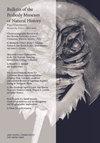失物招领:1915年新墨西哥州二叠纪-石炭纪的杜龙威利斯顿Chamasaurus dolichognathus Williston
IF 0.9
4区 哲学
Q2 BIODIVERSITY CONSERVATION
引用次数: 0
摘要
摘要本文描述了美国新墨西哥州El Cobre峡谷二叠纪-石炭纪Cutler群中“丢失”的斑龙(Chamasaurus dolichognathus)的全型化石。虽然C. dolichognathus被认为是羊膜动物或两栖动物,但我们认为它更可能是泛羊膜动物的一部分。我们还观察到,很少有诊断材料将该标本分配到一个更具体的分支,尽管中等程度的基牙内折可能被证明是诊断实用,如果发现更多的标本。然而,在找到这样的标本之前,我们宣布该物种为nomen dubi。本文章由计算机程序翻译,如有差异,请以英文原文为准。
Lost and Found: Redescription of Chamasaurus dolichognathus Williston 1915 from the Permo-Carboniferous of New Mexico
Abstract Here we describe the “lost” holotype of Chamasaurus dolichognathus from the Permo-Carboniferous Cutler Group of El Cobre Canyon, New Mexico, USA. While C. dolichognathus has been suggested to be either an amniote or amphibian, we conclude that it is more likely a part of pan-Amniota. We also observe that there is little diagnostic material that would assign this specimen to a more specific clade, although the moderate degree of basal tooth infolding could prove to be of diagnostic utility if additional specimens are discovered. However, we declare the species as nomen dubium until such specimens are found.
求助全文
通过发布文献求助,成功后即可免费获取论文全文。
去求助
来源期刊

Bulletin of the Peabody Museum of Natural History
BIODIVERSITY CONSERVATION-ECOLOGY
CiteScore
2.40
自引率
0.00%
发文量
6
审稿时长
>12 weeks
期刊介绍:
The Bulletin of the Peabody Museum of Natural History publishes original research based on specimens, artifacts and related materials maintained in the collections of the Yale Peabody Museum of Natural History’s curatorial divisions. The Bulletin is published twice a year, in April and October.
 求助内容:
求助内容: 应助结果提醒方式:
应助结果提醒方式:


